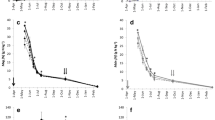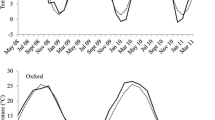Abstract
There is increasing interest in cultivation of Miscanthus as a source of renewable energy in Europe, but there is little information on its nutrient requirements. Our aim was to determine the nutrient requirement of an established Miscanthus crop through a detailed study of nutrient uptake and nutrient remobilization between plant parts during growth and senescence. Therefore dry matter of rhizomes and shoots as well as N, P, K and Mg concentration under three N fertilizer rates (0, 90, and 180 kg N ha-1) were measured in field trials in 1992/93 and at one rate of 100 kg N h-1 in 1994/95.
Maximum aboveground biomass in an established Miscanthus crop ranged between 25-30 t dry matter ha-1 in the September of both trial years. Due to senescence and leaf fall there was a 30% loss in dry matter between September and harvest in March. N fertilization had no effect on crop yield at harvest. Concentrations of N, P, K and Mg in shoots were at a maximum at the beginning of the growing period in May and decreased thereafter while concentrations in rhizomes stayed fairly constant throughout the year and were not affected by N fertilization.
Nutrient mobilization from rhizomes to shoots - defined as the maximum change in nutrient content in rhizomes from the beginning of the growth period measured in 1992/93 was 55 kg N ha-1, 8 kg P ha-1, 39 kg K ha-1 and 11 kg Mg ha-1. This is equivalent to 21 N, 36 P, 14 K and 27 Mg of the maximum nutrient content of the shoots. Nutrient remobilization from shoots to rhizomes ‐ defined as the increase in nutrient content of rhizomes between September and March ‐ measured in 1994/95 was 101 kg N ha-1, 9 kg P ha-1, 81 kg K ha-1 and 8 kg Mg ha-1 equivalent to 46 N, 50 P, 30 K and 27 Mg of nutrient content of shoots in September. Results showed that nutrient remobilization within the plant needs to be considered when calculating nutrient balances and fertilizer recommendations.
Similar content being viewed by others
References
Bolhár-Nordenkampf H R 1992 Ökophysiologische Verflechtungen in einer forcierten Biomasseproduktion. InKongreßbericht Miscanthus sinensis giganteus. Eds. W Geissler and R Puxkandl-Ull. pp 34-46. Verlag Erneuerbare Energien, Gleisdorf.
El Bassam N, Dambroth M and Jacks I 1992 Die Nutzung von Miscanthus sinensis(Chinaschilf) als Energie-und Industriegrundstoff. Landbauforsch. V(ö)lkenrode 42, 199-205.
Escher G and Rupp M 1993 Nachwachsende Rohstoffe f(ü)r Energieerzeugung und Chemie. BWK 45, 406-410.
Greef J M 1996 Etablierung und Biomassebildung von Miscanthus (χ) giganteus. Cuvillier Verlag, G(ö)ttingen. 162 p.
giganteus. Angew. Bot. 67, 87-90.
giganteusin northern Germany. InAlternative Oilseed and Fiber Crops for Cool and Wet Regions of Europe. Eds. S Hennink, L J M van Soest, K Pithan and L Hof. pp 101-112. E Guyot SA, Brussels.
Hartmann H and Strehler A 1995 Die Stellung der Biomasse im Vergleich zu anderen erneuerbaren Energietr(ä)gern aus (ö)kologischer, (ö)konomischer und technischer Sicht. Schriftenr. Nachwachs. Rohstoffe 3, 1-396.
Holz F 1974 Die automatische Bestimmung des Stickstoffs als Indolphenolgr(ü)n in B(ö)den und Pflanzen. Landwirtsch. Forsch. 26, 177-191.
Hotz A, Kolb W and Schwarz T 1989 Nachwachsende Rohstoffe-Eine Chance f(ü)r die Landwirtschaft? Bayer. Landwirt. Jahrb. 66, 15-26.
Imai K and Murata Y 1979 Changes in apparent photosynthesis, carbon dioxide compensation point, dark respiration of leaves of some Poaceae and Cyperaceae species with senescence. Plant Cell Physiol. 20, 165-168.
Koike J, Sh(ô)ji S and Yoshida S 1975 Aboveground biomass and litter in the Miscanthus sinensiscommunity. JIBP Synth.13, 141-147.
Kolb W, Hotz A and Kuhn W 1990 Untersuchungen zur Leistungsf (ä)higkeit ausdauernder Gr(ä)ser f(ü)r die Energie-und Rohstoffgewinnung. Rasen-Turf-Gazon 4, 75-79.
Long S P 1983 C4 photosynthesis at low temperatures. Plant Cell Environ. 6, 345-363.
Mengel K 1991 Ern(ä)hrung und Stoffwechsel der Pflanze. VEB Gustav Fischer Verlag, Jena. 466 p.
Midorikawa B 1978 Method to determine primary production. InHandbook of Grassland Investigation. Ed. M Numata. pp 61- 77. Univ. of Tokyo Press, Tokyo.
Midorikawa B and Masuzawa T 1978 Studies on production processes and net production of the community. JIBP Synth. 19, 222-230.
Midorikawa B, Shimada Y, Iwaki H and Ohga N 1975 Root production in seminatural grassland community dominated by Miscanthus sinensisin Kawatabi area. JIBP Synth.13, 114-123.
Mun H T 1988 Comparison of primary production and nutrients absorption by a Miscanthus sinensiscommunity in different soils. Plant Soil 112, 143-149.
Neukirchen D, Himken M, Lammel J, Czypionka-Krause U and Olfs H-W 1997 Cultivation ofMiscanthus underWest European conditions: Seasonal changes in root distribution. Plant Soil
Nygaard Nielsen P 1988 Produktiviteten of elefantengras Miscanthus sinensis 'Giganteus' pa farskellige jordtyper. Saertryk Tidsskrift Planteavl 91, 275-281.
Schwarz K U, Greef J M and Schnug E 1995 Untersuchungen zur Etablierung und Biomassebildung von Miscanthus giganteusunter verschiedenen Umweltbedingungen. Landbauforsch. Völkenrode, Sonderheft 155, 1-122.
Schweiger P and Stolzenburg K 1993 Energie vom Acker-Anbauversuche mit Miscanthusin der Rheinebene 1989-1993. Informationen f(ü)r die Pflanzenproduktion Heft 1. Ed. Landesanstalt f(ü)r Pflanzenbau, Forchheim.
Shimada Y, Iwaki H and Midorikawa B 1975 Primary productivity of the Miscanthus sinensiscommunity at the Kawatabi IBP area-standing crop of aboveground parts. JIBP Synth. 13, 110-114.
Sh(ô)ji S, Kurebayashi T and Yamada I 1990 Growth and chemical composition of Japanese pampas grass (Miscanthus sinensis) with special reference to the formation of dark coloured andisols in northeastern Japan. Soil Sci. Plant Nutr. 36, 105-120.
Thiemann R 1995 Produktionstechnik von Miscanthus. InSymposium Miscanthus. Biomassebereitstellung, energetische und stoffliche Nutzung. Schriftenr. Nachwachs. Rohstoffe 4, 103- 112.
Thoma H 1991 Pflanzenbauliche, erntetechnische, verbrennungstechnische, (ö)kologische und (ö)konomische Aspekte der energetischen Nutzung von Einjahrespflanzen durch direkte Verbrennung. Bayer. Landwirtsch. Jahrb. 68, 916-988.
Tsuchida K and Numata M 1979 Relationships between successional situation and production of Miscanthus sinensiscommunities at Kirigamine Heights central Japan. Vegetatio 39, 15-23.
Yamane I and Sato K 1971 Seasonal change of chemical composition in Miscanthus sinensis. Rep. Inst. Agric. Res. Tohoku Univ. 22, 1-36.
Author information
Authors and Affiliations
Rights and permissions
About this article
Cite this article
Himken, M., Lammel, J., Neukirchen, D. et al. Cultivation of Miscanthus under West European conditions: Seasonal changes in dry matter production, nutrient uptake and remobilization. Plant and Soil 189, 117–126 (1997). https://doi.org/10.1023/A:1004244614537
Issue Date:
DOI: https://doi.org/10.1023/A:1004244614537




